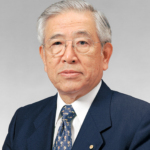The Japan Automotive Hall of Fame has named four individuals to be inducted into their ranks. Each has been chosen for their contributions to Japan’s automotive industry. As with the four cars that were announced this year, there are names that we assumed would’ve already been included long ago. Better late than never, though.
 Shoichiro Toyoda was the sixth president of Toyota Motor. The son of the founder Kiichiro Toyoda, he led the company during its era of greatest growth, from 1981 to 1992. Under Shoichiro Toyoda’s leadership, Toyota its first overseas manufacturing plants and launched the Lexus division.
Shoichiro Toyoda was the sixth president of Toyota Motor. The son of the founder Kiichiro Toyoda, he led the company during its era of greatest growth, from 1981 to 1992. Under Shoichiro Toyoda’s leadership, Toyota its first overseas manufacturing plants and launched the Lexus division.
Even prior to his tenure as president, Toyoda contributed greatly to Toyota’s success. He spearheaded the establishment of the Motomachi plant, Toyota’s first factory devoted to passenger cars and the heart of its manufacturing empire. He was also part of the team that developed Toyota’s kaizen, or “continuous improvement” philosophy to which Toyota’s legendary build quality is attributed.
His efforts culminated with the launch of Lexus and the LS400 in 1989. It transformed Toyota from a maker of dependable but inexpensive vehicles into a creator of desirable luxury cars, which boasted even higher quality than the cars Toyota had built its name on. Shoichiro Toyoda was so revered as captain of Japan’s largest company that when he passed away earlier this year the Prime Minister attended his funeral. It’s a bit surprising he wasn’t already in the JAHoF; the US Automotive Hall of Fame inducted Toyoda in 2007.


Yasuhei Oguchi is an automotive engineer and professor emeritus at Shibaura Institute of Technology. Oguchi authored the books Illustrated Automobile Mechanisms, about the inner workings of cars, and Understanding Automotive Engineering about the principles of “man-machine systems”, covering everything from vibration and ride comfort to maneuverability and stability to ergonomics and safety.
In industry, Oguchi applied his theories of driving control mechanisms between humans and cars into tests that carmakers could use during development, including the creation of a world-renowned lateral motion test stand. Oguchi was also a pioneer in four-wheel-steering theory and worked towards bringing it to production. His writings and lectures have influenced a great number of automotive engineers.


Shoichi Sano was a life-long Honda engineer. Upon graduating from the University of Tokyo in 1960 he began his career in Honda’s design department. Four years later, Sano was transferred to the Formula 1 division, where he was entrusted with designing the Honda RA271, Honda’s first Grand Prix race car. He went on to oversee all of Honda’s early Formula 1 cars, including the RA272, the first Japanese car to win an F1 race, as well as its successors, the RA300 and RA302.
Sano also led the development of the Honda 1300 before being transferred to the safety division. There, he developed the four-wheel-steering system that was launched on the third-generation Honda Prelude. In 1985 Sano was briefly called back to the Formula 1 program to resolve suspension issues on the Honda-powered Williams FW10. Even after his retirement in 2009, Sano stayed connected with Honda and worked on various projects with the company, including the restoration the early Honda F1 cars for the Honda Collection Hall.


Tetsuro Aikawa is the former president of Mitsubishi Motors, a company he joined upon graduating from University of Tokyo in 1978. Early in his career at Mitsubishi, Aikawa worked on models such as the Cordia, Tredia, Galant Σ, and second-generation Debonair.
In 1985 Aikawa was put in charge of the seventh-generation Minica, but he had never driven a kei car before. Upon taking the role he sold his Lancer EX Turbo and bought a Daihatsu Mira Turbo, at the time the best-selling kei car in Japan. It would not be his first non-Mitsubishi; Aikawa later bought an NA Miata as his personal car. “No matter what car you drive, it should be fun,” was Aikawa’s philosophy. Though kei cars were meant to be practical Aikawa wanted to boost the Minica with performance flair, and developed the Minican Dangan.
Aikawa went on to lead the development of the second-generation Diamante, Aitrek (first-generation Outlander), and the eK series of kei cars. Despite all his accomplishments, Aikawa’s induction in to the JAHoF is primarily due to his work on the Mitsubishi i and i-MIEV, the first mass-production lithium-ion EV.






